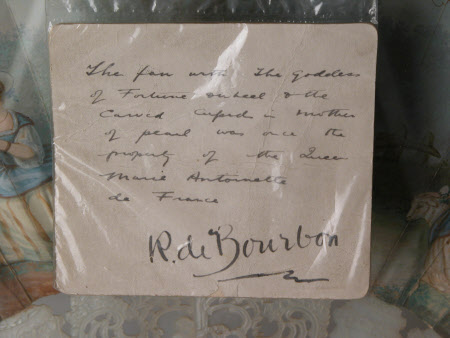Fan
Category
Costume
Date
Unknown
Materials
Paper, Wood, Glass, Marble
Measurements
368 x 583 x 45 mm
Order this imageCollection
Greys Court, Oxfordshire
NT 195548
Summary
Paper lady's fan inset within glass case mounted on marble stand, fan painted with a conversation piece of figures playing blind man's bluff. Handwritten label on back of case signed R. de Bourbon, stating fan belonged to Marie Antoinette.
Full description
Paper lady's fan inset within glass case mounted on marble stand, fan painted with a conversation piece of figures playing blindman's bluff. Handwritten label on back of case signed R. de Bourbon, stating fan belonged to Marie Antoinette. Dates to mid 18th century, pre-revolution. By the mid 17th century the predominant centre of fan production was France. Near end of 17th century the increased demand for fans and the development of production necessitated the re-establishment of the fan makers guild (1676). Pastoral scenes, classical clothes/subjects were common for this period, as were semi-precious materials such as mother-of-pearl, silver, gold sheet inlaying. Sequins, bones and gilding were also common, as was engraving on mother of pearl handles, as seen on this particular example. Signatures on 18th century fans are extremely rare, to extent that any existing signatures supposedly from this period are suspect as probably forgeries. The subject matter seen on the fan is not as innocent as it may seem. Blindman's bluff and swinging are both associated with childhood games, but in France during the eighteenth century, paintings depicting these activities are more sexual that one could imagine. The images were, according to Donal Posner in his article "The Swinging Women of Watteau and Fragonard", "carefully constructed...pictoral patterns and motifs that conveyed narrative, psychological or allegorical meanings" (Posner, 76). The painting of this time of men and women partaking in leisure games should not be read as innocent play, but as erotic images commenting on youth and love at the time. This can especially be seen in images depicting women swinging, and men and women playing blindman's bluff. In the eighteenth century the specific portrayal f women chanced. According to Posner, the people of the timer were becoming less censorious, and more willing to accept sexuality as a natural part of their lives. The games shown in the eighteenth century paintings and the depictions "...provided a space in which behavior and physical expression were given new liberties." (Milam, 545). Also seen in the rococo period is the abundance of pastoral landscapes, Although landscapes have always been present in art, their popularity increased during the eighteenth century. Scenes showing the country life were the escapist fantasy for the upper classes at the time. These were places where the elite could abandon courtly etiquette and fraternize without cares, while being able to pursue members of the opposite sex. Images from the Rococo period in France did not only comment on favourite games, but on the game of love. By using sexual metaphors, artists of this time hinted at the passions of young love, a theme that had been suppressed in the Renaissance.
Provenance
Gifted to the National Trust from the Estate of Lady Elizabeth Brunner, 2005.
Marks and inscriptions
Back of frame: Paper label on back of frame. On one side in handwritten script it states 'The fan with the Goddess of Fortune on heel [?] and the carved cupids in mother of peal was one the property of the Queen Marie Antoinette of France' and signed 'R. de Bourbon'. The back of the label features a print of angels with the text 'H.R.H. THE PRINCE REGNIER of BOURBON / INVERNESS HOUSE MERTON, SURREY'

